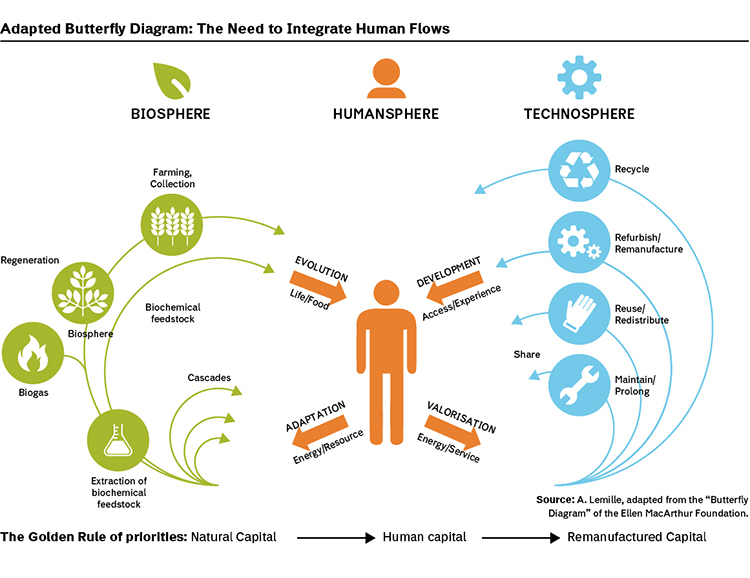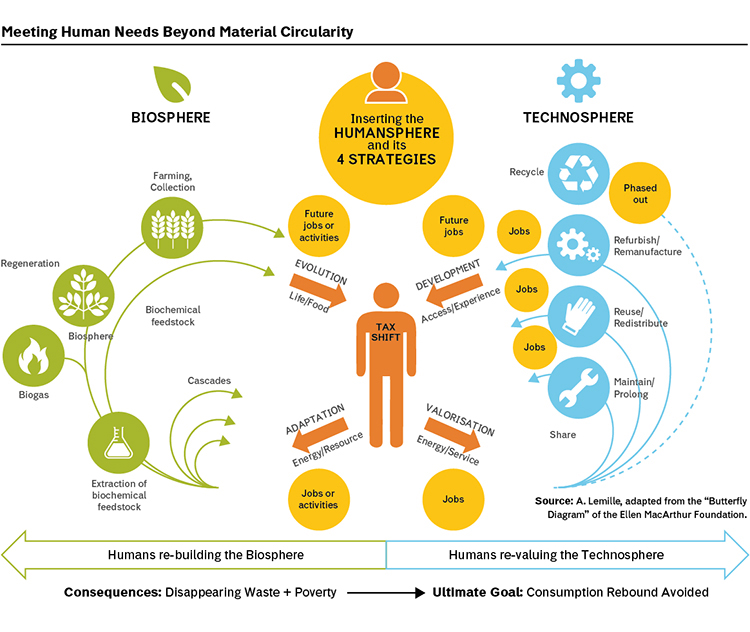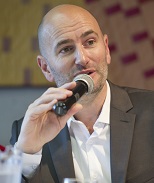In his famous book The Ecology of Commerce, Paul Hawken wrote: “[...] we have to look at how our present economic system consistently rewards short-term exploitation while penalising long-term restoration, and then eliminate the ill-placed incentives that allow small sectors of the population to benefit at the expense of the whole. [...] We need to imagine a life where having less is more satisfying, more interesting, and more secure.”
Economist Kenneth Boulding described this economy many years ago, one in which an affluent life “will have to be combined with a curious parsimony [...] every grain of sand will have to be treasured, and the waste and profligacy of our own day will seem so horrible that our descendants will hardly be able to bear to think about us.”
From the Fake to the Real Economy
Our economic model has been based on the fake belief that we can grow endlessly without any proper understanding of the costs burdened on the environment. To this day we continue to believe that the economic is separate from the environmental, and, on top of this, our artificial world is alienating us completely from the reality in which we live.
The traditional concept of economic growth only shows us the positives of economic prosperity. In fact, in books on economics we are never shown the “hidden growth” of environmental depletion.
To include both these elements is to think in circular economy terms, a system that is restorative and regenerative by design. Yet, there is still a tendency to over-look a fundamental aspect: the real decoupling of our pressure on resources from the advancement of humans (and not necessarily their growth).
Room for Innovation
We have finally come to realise that our world is finite. The Circular Economy is helping us understand how to align our lifestyles and our businesses with natural cycles. Re-designing our economic system and providing equitable opportunities – so that we can all thrive.
Changing the relationship between the environment and the economy is important, but the need to change ourselves while embedding humans within that model is even more so. This is well explained in the recent research called “Circular Economy Rebound” (Zinc & Geyer, 2017) where a potential solution to avoid rebound is to address social needs over economic ones.
What we call the Technosphere (technical goods circulating in our economy), based on fossil fuels, is at the heart of most of the damage inflicted on planet Earth. Fixing the cracks will not be easy. One way to achieve this is to look at where the largest stocks of resources are.
There are two such stocks that open up endless room for innovation:
The Biosphere stock – this is an endless and the biggest source of innovation. It is a self-regenerating eco-systemic metabolism that helps us understand ways to create abundance of flows;
The Human stock – we are numerous and growing fast, yet, we tend to overlook our own potential.
Abundance = Biosphere + Humans
Our Technosphere (as depicted in the “Butterfly Diagram” of The Ellen MacArthur Foundation) is dependent on elements. They are our “Limited Resources.” They must be preserved and their quality maintained, whilst ascribing them with the highest possible value. Here, our primary focus is to reduce energy consumption, unleash access (over ownership), and maintain high value.
Our Biosphere follows natural cycles. It is our “Disappearing Resources.” Yet, we can all learn from the way nature regenerates itself so that we aim at developing all aspects of our life according to the abundance of flows. Our primary focus here should be mimicking these cycles.
Us, Humans. We represent the “Abundant Resources.” According to Walter R. Stahel, we are highly versatile and represent an endless source of energy. This very fragile stock of resources needs to keep education, knowledge and skills as high as possible at all times.
Although highly valuable, there is no sphere dedicated to “us.”
We need a comprehensive economic plan where the rewards are the re-abundance of environmental services and re-investment in human capital. The decision making process – also called “the Golden Rule” – would be to first rebuild Natural Capital, then focus on Human Capital prior to looking at solutions in Re-manufactured Capital.
Preserving and rebuilding our Biosphere is our common number one priority. The only time we should use the word “growth” is for the Biosphere, and not for any other sphere. Yet, protecting both the Technosphere and the Biosphere, requires a questioning of our role in relation to them. How are we going to preserve them if we don’t change our relationship to them?
Human Capital needs to be used adequately to rebuild the Biosphere and maintain the Technosphere, so that we can address our needs for advancement in a clever manner. By disseminating Human Capital into both we can change the equation. Therefore, reconsidering our relationship with nature and the “real” role of the economy (back to its original definition of providence and carefulness).
The Adapted Butterfly Diagram
There is a need to integrate human flows as part of this diagram to understand whether we are creating value in both spheres. The original approach of the diagram was to explain ways to move from a linear economy (the central spine) to the creation of feedback loops. Integrating humans in it (thanks to the Humansphere) only helps us see our potential role(s) in an advanced circular scenario while preserving a balance between all spheres.

On the one hand, our relationship with the Biosphere should evolve. The Adaptation Strategy – whereby we see ourselves as endless energy and endless resources – is the necessary approach. Taking inspiration from the example of ants: their total mass is greater than that of all humans on the planet, yet they build their ecosystems every day. Why can we not do the same? Why not develop a strategy where we recreate and expand the Biosphere?
The feedback loop from the Biosphere is about providing us with better living conditions and better food (the Evolving Strategy).
On the other hand, humans should be considered as sources of endless energy and services to enhance the value of the Technosphere (the Valorisation Strategy). Here, we would consider ourselves as a highly skilled and knowledgeable stock of resources. Repairing goods and solving problems collaboratively could be done by humans both efficiently and effectively.
The feedback loop from the Technosphere provides us with different points of access to a world of experiences (the Advancement or Development Strategy). Redesigned with less energy and less primary resources, this sphere would help advance us towards “real” progress.

Becoming Restorative Beings
There are two main business models from the Humansphere:
Humans-as-Resources: this is our Input Model. We are nature. As part of it, we will define adaptable strategies for rebuilding the Biosphere using our energy and our matter;
Humans-as-Services: this is our Output Model. We are power. Using our endless energy to provide services that would care for the Technosphere is our best option to avoid a Circular rebound;
Examples of Humans-as-Resources
Dycle (Humans-as-Matter): young families in Berlin are provided with free bio-compostable diapers for their newly born babies in exchange for the babies’ input. Collected in a central service point, this human-based solution is used to prepare a rich black humus that is then used to help grow fruit trees. By creating a new loop, Dycle provides diapers and generates value by selling fruit.
Permaculture (Humans-as-Ecosystem-Builders): the famous permaculture film-maker John D. Liu has proven throughout many years of filming that we can rebuild large ecosystems (dry mountains, deserts, etc.) by understanding how systems work. His movies show deserts and mountains in Ethiopia, China and Jordan turned into lush forests with their water cycles being rebuilt.
The Maoxian Ladies (Humans-replacing-Bees): in the Sichuan Region of China, bees have disappeared. Carefully using their endless energy, the Maoxian ladies are hand-pollinating fruit trees by carrying the pollen into each flower in the trees. While finding a way to rebuild the community of bees in the region, they are replacing the functions once undertaken by the bees, ensuring the continuation of their agricultural system.
Senegalese Mangroves (Humans-protecting-Fish): known as the largest mangroves in the world, for the past ten years villagers in Senegal have decided to act on the disappearing mangroves, protecting the fish population so that they can continue to reproduce. By rebuilding the mangroves, villagers ensure that fish can access food in the coming years, whilst reducing the imbalances in their ecosystem.
Examples of Humans-as-Services
Mercedes-Benz (Humans-assisting-Robots): earlier this year, humans returned to the manufacturing plant of Sindelfingen, Germany, as robots could not keep up with the high level of customisation required in S-Class cars. Highly versatile and instantly adaptable, workers are now assisting robots so that a better service is delivered providing both efficiency (robots & humans) and effectiveness (humans).
Suame Car Repair Cluster (Humans-extending-Life-Use): for years, Ghanaians had to use second-hand cars shipped from Europe with either no spare parts or a very limited stock. Growing into a cluster of nearly 12,000 businesses, employing 200,000 people, the Suame car cluster shows how adaptive and innovative people have been to ensure cars stay in a functioning state on the streets of Accra for the longest time possible (from 10 to over 30 years).
Hand Repaired Goods (Humans-as-Service): last year, Sweden was the first country to pass a law that would give preference to human-based activities of fixing and repairing consumer goods. The VAT tax dropped from 25% to 12%, a great starting point to unleash the potential of labour to service goods in Sweden so that they last longer.
A Future of Endless Jobs or Activities
This is what the Ex’Tax Project (Value Extracted Tax) aims to achieve. First initiated by Eckart Wintzen (1939-2008), Ex’tax is the proposal to bring tax on natural resource use up and tax on labour down. “This creates incentives to save natural resources. It also makes services more affordable and boosts manpower, craftsmanship and creativity.” In the Ex’Tax report, estimates have been calculated to make this proposal a viable one for Governments, for businesses, for us the potential employees, for the people, and also for the planet.
Ex’Tax is a step towards the full implementation of the desired Humansphere, unleashing our energies, our powers and endless innovation.
Let us now look at the generic estimates of the number of jobs created per tonne of goods, as elaborated by the RREUSE social enterprise in their “Briefing on job creation potential in the re-use sector,” using Environmental Protection Agency data contained in the “Resource Conservation Challenge. Campaigning Against Waste” study.
In an incineration-based economy, we create one job for every 10,000 tonnes of goods produced; in a landfill-based economy, we create six jobs for every 10,000 tonnes of goods; in a recycling-based one, 36 jobs; in a service-based model, i.e. an early stage Circular Economy scenario, 296 jobs could be created.
The question is: how many jobs can we create by adding human-based business models to the equation? In an advanced scenario where Ex’Tax is implemented (Humans-as-Service model), we could create up to 400 more jobs for every 10,000 tonnes of goods produced? A distributed economy based on highly versatile services, can only be inclusive of its people. This new paradigm has the potential to benefit all of us.
“Butterfly diagram” Ellen MacArthur Foundation, www.ellenmacarthurfoundation.org/circular-economy/infographic


